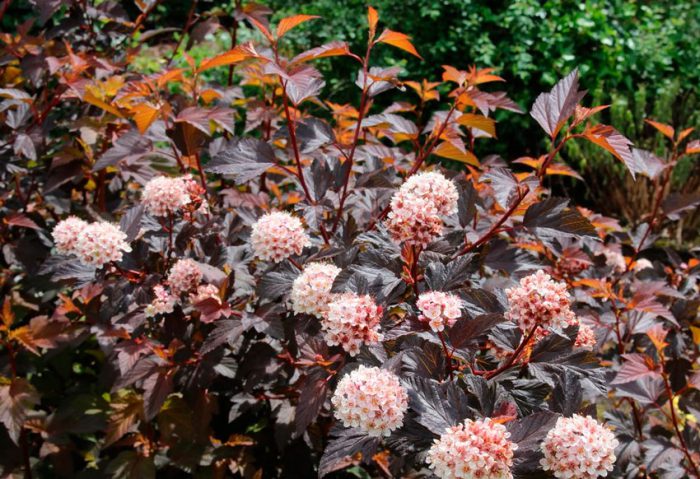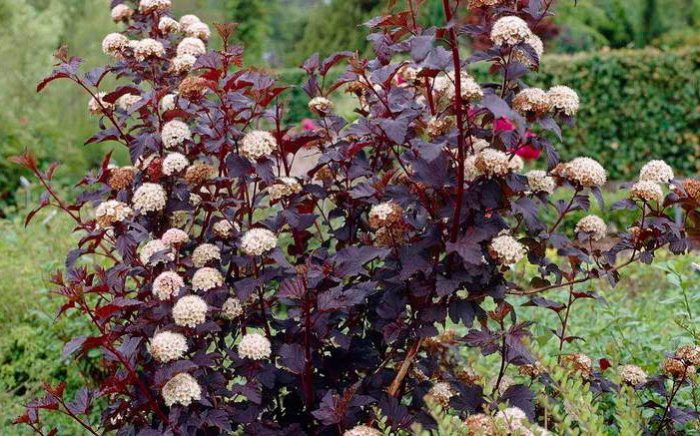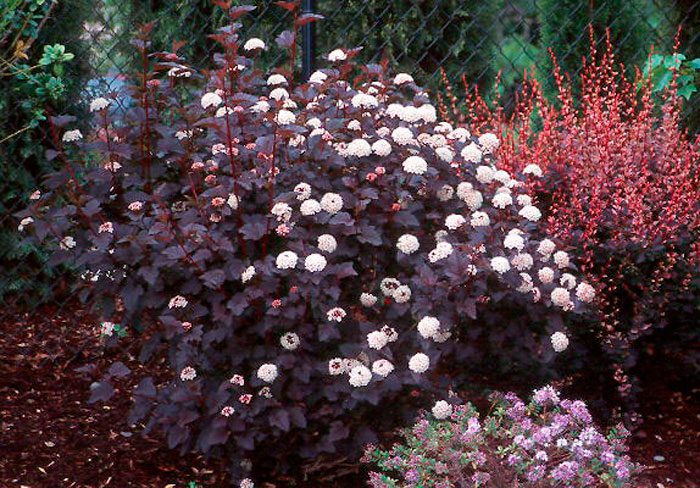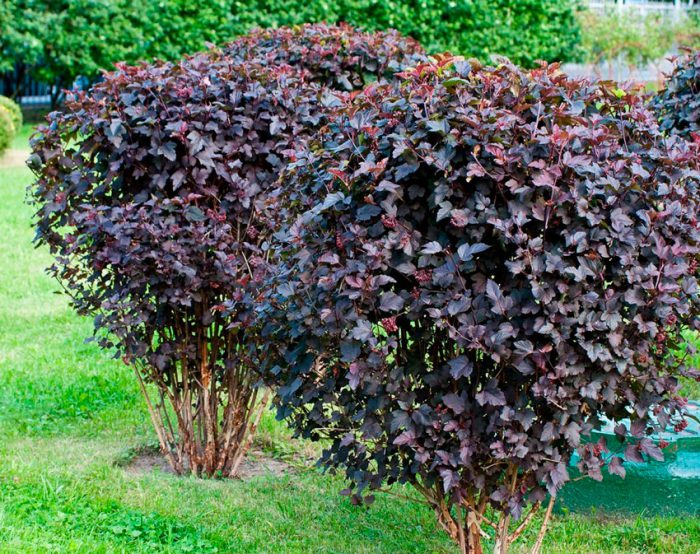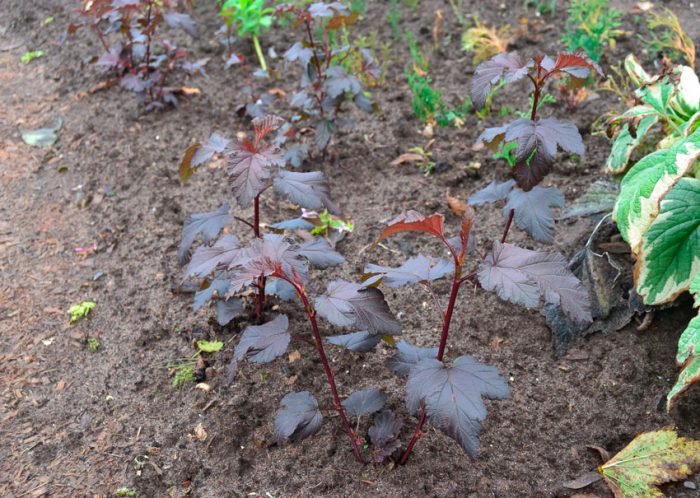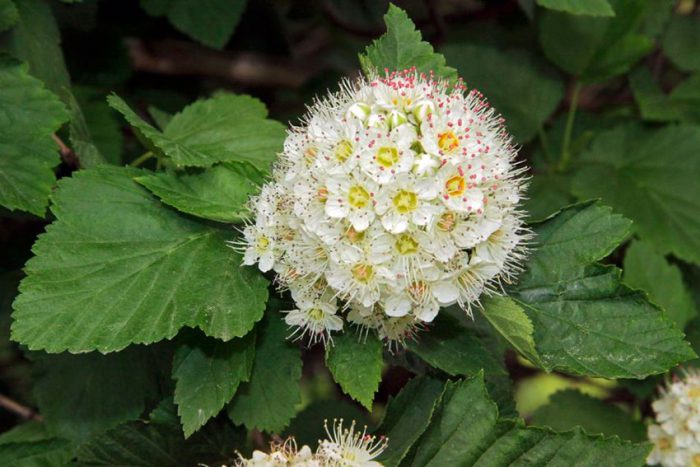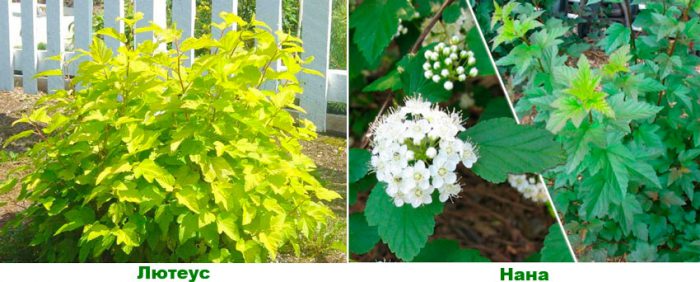The deciduous shrub (Physocarpus) is a member of the rose family. The Latin name of such a plant consists of 2 roots of the ancient Greek language, namely: "physo" - "bubble" and "carpos" - "fruit". There are 14 species in this genus. In the wild, the vesicle can be found in North America and East Asia. When grown in a garden, this shrub is distinguished by its unpretentiousness, as well as the fact that it is able to maintain its spectacular appearance throughout the growing season. Also, this shrub is fast-growing and resistant to air pollution. Such a plant is grown as a single plant and is used in landscape design. However, the most impressive hedge is from the bladder.
Content
Features of the vesicle
The sprawling bush of the vesicle consists of drooping branches that form a lush spherical crown. In an adult shrub, the bark peels off, and in wide strips. In height, it can reach 300 centimeters. Three to five-lobed leaf plates in shape resemble viburnum leaves. Simple white flowers have many stamens. They are part of hemispherical inflorescences, which can reach 5-7 centimeters in diameter. Lush bloom occurs in early summer. The fruits of such a plant also look quite impressive, they are swollen leaflets, which, when ripe, turn red. Only 2 types of vesicle are cultivated, while there are several spectacular varieties, the leaf plates of which have different colors.
Planting the vesicle in open ground
What time to plant
If you managed to buy seedlings with a closed root system in a nursery or garden center, they can be planted in open soil at any time of the year (but not in winter). If the purchased seedlings have an open root system, then for planting them, you should choose spring, and best of all, autumn.A well-lit, open place is suitable for planting such a plant, next to which large trees will not grow. In the event that the variety has a green leaf color, then such a shrub can grow normally in a shaded area. The bladder is not picky about the soil, but it must be well-drained, and lime must be included in its composition. If you want it to have the most decorative look, then you should choose a loose loamy soil saturated with nutrients.
How to plant
When preparing a planting hole, it should be remembered that its size should be such that a layer of soil saturated with nutrients (or an earth mixture consisting of peat, turf, earth and sand) can fit in it, while the root collar of the seedling after planting should be flush with the surface of the site. In this regard, it is recommended to prepare a hole by digging it and filling it with fertile soil half a month before the planned planting day, in this case the soil will have time to settle well. The seedling is placed in the planting hole together with an earthen lump, while remember that fertilization should not be applied to the soil during planting, since the young plant is simply not able to assimilate it normally. Then the hole will need to be filled with a soil mixture (the composition is described above) or soil saturated with nutrients. The planted shrub needs abundant watering. If the soil settles after watering, then you will need to add it. The first days should be monitored to ensure that the near-stem circle of the vesicle is constantly slightly damp. The surface of the site should be covered with a layer of mulch (humus or peat).
Bladder care
When caring for such a plant, it is very important to water it on time, as it reacts extremely negatively to drought. When watering, make sure that the liquid does not get on the surface of the leaf plates and inflorescences, as this can lead to burns. In this regard, this procedure is recommended to be performed early in the morning or in the evening. In the summer, during the hot period, watering will need to be carried out about a couple of times a week, while at the same time 4 buckets of water should go to 1 bush. Observe the state of the bladder leaves, because not only drought, but also waterlogging of the soil can harm it. In the event that the site is not covered with mulch, then every time after the shrub is watered, it is necessary to loosen its surface and weed.
You need to feed the plant a couple of times a year (in spring and autumn). In spring, the plant should be fed with the following nutrient mixture: for 1 bucket of water, take a five-hundred-gram can of mullein, as well as 1 large spoonful of urea and ammonium nitrate. For 1 adult bush, 1.5 buckets of such a solution are taken. In autumn, one and a half buckets of nutrient solution should be poured under each bush, consisting of 10 liters of water and 2 large spoons of nitroammophoska.
Pruning
This shrub requires systematic sanitary and formative pruning. In spring, it is imperative to prune for sanitary purposes, for this, all injured, diseased, frost-affected stems and branches, as well as those that grow inside the bush, are cut off. By pruning the vesicle in the fall, you are preparing it for the coming winter. Pruning to form a crown can be done in the fall, but experienced gardeners recommend doing it in the spring. In order for the bush to have the shape of a fountain, you need to cut off all the thin stems at the base, leaving 5 or 6 of the most powerful ones, which must be shortened a little. If you want the bush to be wide, you need to cut it at a height of 50 centimeters. When the shrub is 6 years old, they produce anti-aging pruning on a stump. On thick stems, the places of the cuts should be smeared with garden var.


Watch this video on YouTube
Transfer
In some cases, it becomes necessary to transplant this plant, for example, you need to transfer it to another place. If the shrub is already adult, then it should be transplanted in early spring, before the buds swell, or in the autumn, when leaf fall ends. The bush is transplanted with a sufficiently voluminous earthen clod, while first pruning is done, during which the injured, diseased and thickening stems are cut off, and the remaining ones should be shortened to 0.2-0.3 m. Thanks to this, you will be able to put a load on the root system weaker, because during adaptation it will be extremely difficult for her to feed an adult plant. The transplant is carried out in almost the same way as the planting, it should only be taken into account that the vesicle in this case is already an adult. The transplanted bush must be watered using a solution of Heteroauxin or Kornevin, and you also need to spray the leaf plates with Epin or Ecoel-antistress.
Diseases and pests
It is quite simple to plant and grow a bubblegum, and the gardener will also be pleased that it has a very high resistance to pests and various diseases. However, if the soil does not get nutrients, then the plant develops chlorosis, due to which the apical stems dry out and the young leaf plates turn yellow. If you notice signs of this disease, then you should spray the foliage or water the bush itself under the root with a solution of Ferrylene, Antichlorosis, Ferovit, but experienced gardeners recommend using Iron Chelate. As a rule, after this procedure, the vesicle recovers very quickly.
Reproduction of the vesicle
The bladder can be easily propagated in a vegetative way, namely by cuttings, layering, and by dividing the bush. The generative (seed) method of reproduction is also suitable for this. Seeds are sown in spring or autumn, while first they must be stratified within 30 days. However, you should be aware that shrubs grown in this way rarely retain the rich color of the leaves, which is inherent in the parent plant. And also growing a vesicle from seeds is a rather laborious process. In this regard, it is recommended to resort to vegetative methods for its reproduction.
Cuttings
Cuttings should be harvested before the bush blooms. To do this, cut off the green shoots of this year. The length of the cuttings can be from 10 to 20 centimeters, and each of them should have 2 or 3 internodes. All leaf plates at the bottom of the cutting must be cut off, and those at the top are shortened by ½ part. Prepared cuttings must be immersed in a solution of a means of stimulating root formation (for example, Kornevin). Then they are planted in a training bed in an earth mixture consisting of peat and sand. They are watered and covered with polyethylene film. It is very simple to care for the cuttings, they must be watered and systematically ventilated on time. In winter, rooted cuttings need shelter, and in spring they can be planted in a permanent place.


Watch this video on YouTube
How to propagate by layering
This breeding method is the simplest and most effective. In springtime, the most powerful and absolutely healthy shoot should be selected, which must necessarily grow outward. All leaf plates should be cut off from it, leaving only those growing at the very top. Then this stem is placed in a previously prepared groove, the depth of which should be about 12 centimeters, then it is fixed using a brace made of wood (you can take hairpins for hair), then the groove must be filled with soil. Throughout the growing season, the cuttings will need timely watering, weeding and loosening of the soil surface.By the onset of the autumn period, the cuttings will have to give roots, and it must be separated from the parent bush and covered for the winter.
How to propagate by dividing a bush
By dividing the bush, it is best to propagate the bladderwort. This procedure is performed in spring or autumn. However, if you have experience and certain skills in this matter, then you can divide the bush in the summer. In order for this procedure to end successfully, it must be carried out very quickly, because the root system, which is in the fresh air, should in no case dry out.
Bubbles in winter
Autumn care
In the autumn period, this shrub looks especially impressive, because it is at this time that the foliage is painted in different colors. It has a relatively high frost resistance and in winter, as a rule, only those branches that have not had time to ripen freeze. But it should be borne in mind that rooted cuttings, like young specimens, need shelter for the winter.
Preparation for wintering
In the event that forecasters predict a very frosty winter, then adult vesicle bushes should also be covered. To do this, you need to carefully pull off the bush with twine, and then "put" a cone of roofing material on it or loosely wrap it with lutrasil. However, first you need to cover the surface of the trunk circle with a layer of mulch (peat), the thickness of which should be from 5 to 8 centimeters. Young shrubs should be cut off, their trunks should be mulched, and then covered with spruce branches.
Types and varieties of bladderworm with photos and names
At the moment, only 2 species of the vesicle are cultivated, as well as their varieties and varieties.
Amur bubblegum (Physocarpus amurensis)
This species can be found in natural conditions in North Korea, North China and the Far East, while it prefers to grow in mixed forests. The height of such a shrub with a spherical crown is about 300 centimeters. Young stems are brownish-red and smooth, while on old trunks, the bark is peeled off in longitudinal stripes. The three- to five-lobed leaf plate has a heart-shaped base and is about 10 centimeters long. Their front surface is dark green, and the seamy surface is whitish-gray, because star-like felt hairs are located on it. Corymbose inflorescences consist of 10-15 white flowers with one and a half centimeter diameter. Flowering lasts approximately 20 days. The fruit is a swollen leaflet that turns red when ripe. This species is highly frost-resistant. It is used to create hedges, as well as in group and single plantings. Cultivated since 1854 The most popular forms:
- Luteus... In the summer, the leaf plates are painted in a deep yellow color, and in the autumn they turn bronze.
- Aureomarginate... The leaf plates have a dark golden edging.
- Nana... Such a dwarf shrub has dark green monochromatic leaf plates.
Bubble plant (Physocarpus opulifolius)
The homeland of this species is the eastern part of North America, while it prefers to grow in undergrowth and on river banks. This shrub with a lush hemispherical crown in height can reach 300 centimeters. Elliptical three- to five-lobed leaf plates have an elongated large middle lobe and a serrated edge. Their front surface is green, and the wrong side is painted in a paler shade, sometimes it can be pubescent. Small (about 1.2 cm in diameter) flowers have pink or white color, and red stamens. The fruit is a swollen, assembled pale green leaflet that turns red when ripe. This type can be used to create a hedge, as well as in single or group plantings. Cultivated since 1864 The most popular varieties:
- Darts Gold... The height of a dense and wide bush can be up to 150 centimeters.Yellow leaf plates turn greenish-yellow in summer. The racemose inflorescences consist of white or pink flowers.
- Diablo (red-leaved)... The height of the bush is about 300 centimeters. The color of its foliage is purple or dark red. If the bush is grown in a shaded place, then its leaves will be green with a purple tint, and when grown in a sunny place, they have a red color. In autumn, the color of the foliage does not change. This variety is the most popular.
- Red Baron... The height of the bush is about 200 centimeters. The bare oval three-to-five-lobed leaf plates reach 7 centimeters in length and have a serrated edge. They are colored in a spectacular dark red and are narrower than Diablo's vesicle. Umbellate inflorescences consist of white flowers with a pink tint, reaching a diameter of 5 centimeters. The red fruits also look quite impressive, which include from 3 to 5 pointed sacs. This variety is one of the most valuable.
- Lady in Red... The bush can reach a height of 150 centimeters. This variety was bred by breeders from England. The leaves of a deep red color gradually darken. The color of delicate flowers is white-pink.


Watch this video on YouTube

